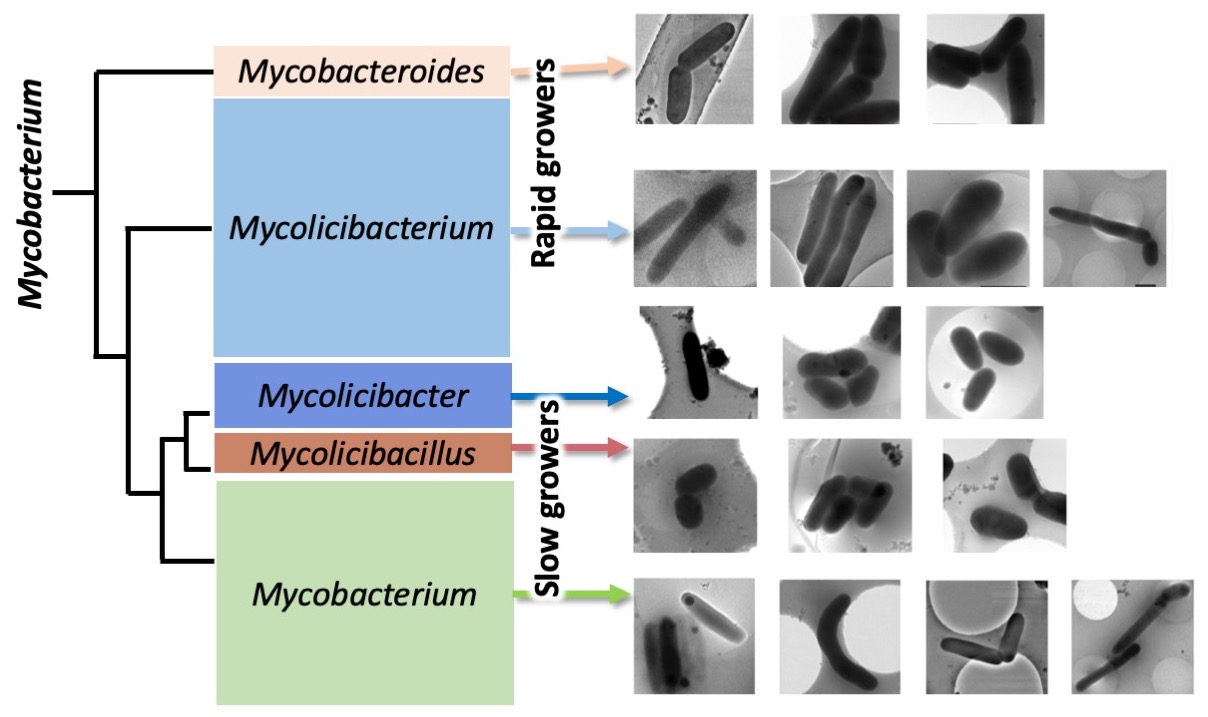The five newly proposed genera of Mycobacterium tuberculosis exhibited different morphological characteristics
The classification of living organisms is mainly based on the genetic comparison of 16S ribosomal RNA sequece that all organisms have. Its morphology is also in good agreement with classification based on the 16S ribosomal RNA sequence comparison, as humans and monkeys differ. However, in recent studies, it has become clear that some tubercle bacilli (Family Mycobacteriaceae) grow slowly and some are fast-growing among the bacteria classified into the same genus Mycobacterium. Therefore, genetic analysis of the core protein of Mycobacterium tuberculosis was carried out, and as a result, it became clear that the genus Mycobacterium, which was previously thought to be one type, consists of five more strain groups. There are two species, Mycobacteroides and Mycolibacterium, which grow relatively fast, and three species, Mycolibacter, Mycolibacillus, and Mycobacterium, which grow relatively slowly. However, it was unclear whether these were also morphologically different.
In this study, a detailed morphological comparison of these five newly classified bacteria was performed using a cryo-electron microscopy. Since the inside of an electron microscope is evacuated so that electron beams can pass through it, biological samples containing water, including tubercle bacilli, will dry out and change in shape and size. With a cryo-electron microscopy, a sample can be embedded in ice and observed, so an image close to the original appearance can be obtained. As a result of statistically comparing the length, width, roundness, etc. of the bacteria using this methodology, it was found that the five types of bacteria also show significant morphological differences (Fig. 1). It was considered that even tubercle bacilli of the same genus have undergone detailed morphological evolution according to the environment in which they grow in the trachea of the animal.
These results revealed that more detailed evolution that cannot be classified by comparison of 16S ribosomal RNA sequence is progressing in bacteria, and that 16S rebosomal RNA sequence does not directly determine phenotype of the organisms although it is specific for each species. Therefore, these are reflected in the most important factors for adapting to the growth environment of morphology. These findings are expected to contribute significantly to the development of new preventive methods and therapeutic agents in the future.

Fig. 1: Five newly proposed genera of Mycobacterium tuberculosis
Collaborative Researcher
Hiroyuki Yamada (The Research Institute of Tuberculosis, JATA)
Kazuyoshi Murata (NIPS)
Funding
AMED, Collaborative Study Program of NIPS
Release Source
Title: Fundamental cell morphologies examined with cryo-TEM of the species in the novel five genera robustly correlate with new classification in family Mycobacteriaceae
Authors: Hiroyuki Yamada, Kinuyo Chikamatsu, Akio Aono, Kazuyoshi Murata, Naoyuki Miyazaki, Yoko Kayama, Apoorva Bhatt, Nagatoshi Fujiwara, Shinji Maeda, Satoshi Mitarai
Journal: Frontiers in Microbiology
Issue: Vol. 11, 562395
Date: 16 November, 2020
URL: https://doi.org/10.3389/fmicb.2020.562395

